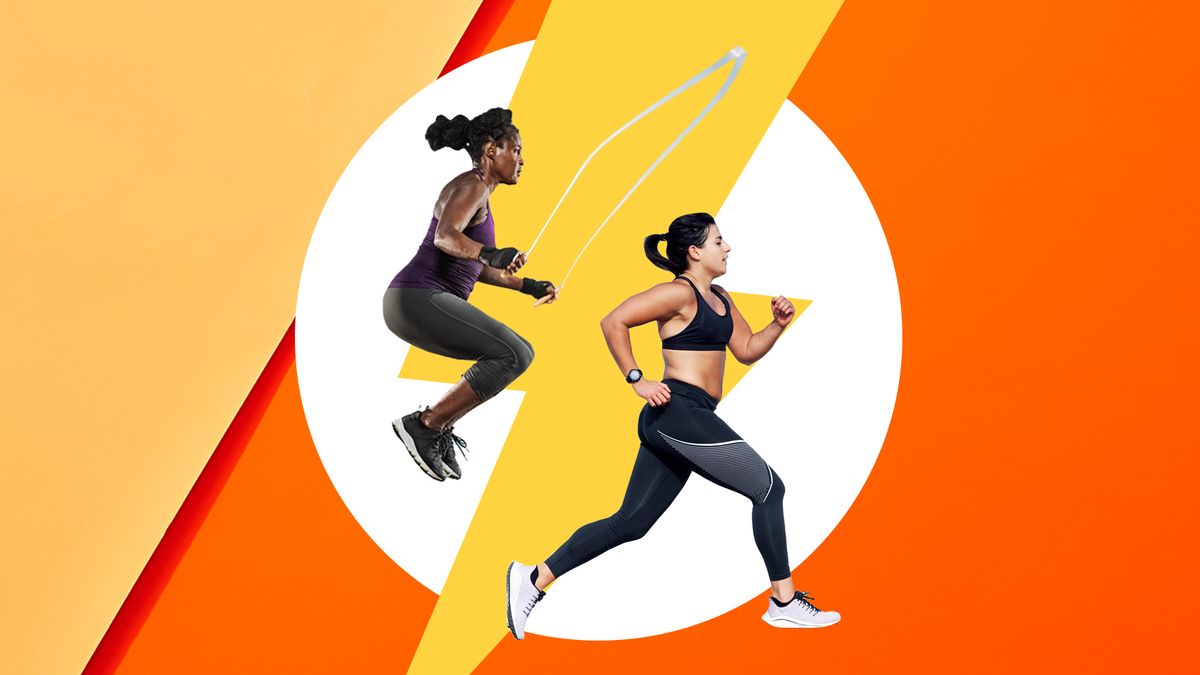Here’s the thing about cardio: It's necessary for strengthening your heart and efficiently pumping blood throughout your body, research proves. To log your recommended 150 minutes of moderate cardio weekly (American Heart Association), you have so many options.
Running and jump rope are two of the best heart revving workouts you can do, minimal equipment required. But, which one is better? When you're short on time, you want to know your jump rope sesh or run is worth your effort.
Meet the experts: Lewis Moses, is a certified running coach, running advisor for INCUS Performance, and lead coach at New Levels Coaching. Chiheb Soumer, CPT, is a retired professional Muay Thai fighter and founder of Los Angeles-based Fairfax Training Club.
Here's the short answer in the jump rope vs. running debate: They both really rock and for many reasons.
Running is a full-body workout that boosts cardiovascular endurance, aids in weight loss, and increases longevity, says Lewis Moses, a certified running coach and running advisor for INCUS Performance. “Running encourages people to get outdoors (when possible) and it can provide an escape from everyday life.”
Jump rope, on the other hand, is great for a quick cardio sesh that activates your entire body while improving coordination and building muscle, adds Chiheb Soumer, CPT, a retired Muay Thai fighter and founder of Fairfax Training Club. “Jumping rope is one of the most efficient ways to burn calories in a shorter time, making it an extremely effective workout for anyone looking to add something new and challenging into their routine."
But there’s a lot more to know about how jumping rope compares to running to decide which cardio workout is right for you. Read on for expert insight on the pros and cons of jump rope vs. running, plus how to know which is best for you and your fitness goals.
Pros And Cons Of Running
Pros:
- Improves cardiovascular endurance
- Aids in weight loss
- Reduces stress
- Promotes longevity
- Better follow-through
Cons:
- Overuse injuries can be common
- Hard on your body
- Safety risks higher
Health Benefits Of Running
It improves cardiovascular endurance. Running is associated with building a strong and healthy heart and has robust cardiovascular benefits, says Moses. Plus, research supports that running is one of the best ways to boost cardiovascular health by lowering your resting heart rate – the number of heart beats per minute when you’re at rest.
It aids in weight loss. Running burns more calories than other workouts, making it great for weight loss, because studies show it requires a variety of different muscles (arms, legs, and abs!) to work in conjunction, ultimately increasing caloric burn. And while running is a great tool for those looking to lose weight and create positive exercise habits, it’s critical that you fuel your body correctly with proper food and water before training, adds Moses.
It reduces stress. Running provides an escape from day-to-day stress and helps to releases endorphins in the body, says Moses. “Endorphins are often referred to as ‘feel-good’ chemicals because they help us to feel happy or provide us with pleasure and satisfaction,” he explains. Research has also continually shown running to have positive mental health benefits by improving mood and/or self-esteem.
It promotes longevity. Compared to non-runners, studies show that running even just five to ten minutes a day reduces the risk of death (from all causes) by 30 percent, and lowers the chance of cardiovascular disease by 45 percent.
It improves follow-through and commitment. Because cardio exercise requires extended and consistent effort (hello, long, hot runs), doing it regularly can improve your ability to stick through lengthy and arduous to-do's elsewhere in your life, according to research out of the University of Iowa.
Potential Drawbacks Of Running
Overuse injuries can be common. “Many runners will experience some sort of injury caused through running, and this is often linked to running volume, intensity, or [incorrect] running mechanics,” says Moses. Unfortunately, injuries are not 100 percent avoidable, but strength and conditioning, proper form mechanics, intensity and volume management, and adequate rest and recovery can all reduce the risk, he explains.
It's hard on your body. “Catching the running bug can be great but going too hard too soon can be detrimental [on your body] in the long run,” says Moses. “Always start easy, build into it sensibly, and allow yourself adequate rest and recovery between training sessions.”
You can encounter safety risks on the road. Safety is non-negotiable, so it’s imperative to take proper precautions when running outside alone or at night. “It’s important to put your own safety over everything else, so if you are running in the dark, you should always consider wearing reflective clothing and invest in a head torch or running body torch,” says Moses. If you run alone, stay vigilant, run on well-lit paths that you are familiar with, and always carry a phone or watch that can make calls.
Pros And Cons Of Jumping Rope
Pros:
- Improves coordination
- Builds muscle
- Burns calories
- Portable equipment
Cons:
- Adds stress on your joints
- Can be difficult for beginners
- High pressure on your cardiovascular system
Health Benefits Of Jumping Rope
It improves coordination. Jumping rope requires you to move multiple body parts at the same time (at a steady cadence and pace) in order to successfully perform the movement, in turn consistently working on your coordination, says Soumer. Plus, jumping to a rhythm improves balance and agility, studies also show.
It helps build muscle. “Jumping rope is a great workout to tone your calves, legs, shoulders, and arms,” says Soumer. “Your lower body works hard, specifically your calves, hamstrings, quads, and glutes, however, your entire upper body is also hard at work as your core is engaged to keep you upright, and your shoulders, biceps, triceps, and forearms are relied on to help control the rope.”
It burns calories. Research shows that jumping rope can burn 200 to 300 calories in 15 minutes since the movement works all your major muscle groups. “Jumping rope burns more calories per minute and engages more muscles than swimming or rowing,” adds Soumer.
It's portable. Looking for a quick cardio burst while on-the-go? Jump ropes are lightweight, portable, and easy to throw in any bag, says Soumer. All you need is the rope and an open space!
Potential Downsides Of Jumping Rope
It adds stress on your joints. Research shows that jumping can put pressure on your joints, so too much can lead to injury or pain. “Because of the repetitive nature, jumping rope can add stress to your joints, like your knees and ankles,” says Soumer. “If you are predisposed to any issues [or injuries], it’s best to speak with your doctor.”
There's a learning curve. This makes jumping rope a bit more difficult for beginners. “Because of the coordination required, it can be challenging to learn and become skilled enough to experience the full benefits of jump roping,” says Soumer. If you’re new to the activity, start out slowly to learn the form and rhythm before focusing on duration.
It's taxing on the cardiovascular system. “If you are prone to high blood pressure or cardiovascular problems, doing any sort of HIIT activity, jump rope included, can be potentially dangerous,” says Soumer. Because jumping rope is an aerobic exercise, studies show it puts pressure on your cardiovascular system, so always talk with your doctor.
How do jumping rope and running compare?
Running and jump rope are both full-body, low-cost, and minimal-equipment required exercises, so choosing one is all about your personal goals, says Moses. Both forms of exercise require a certain level of plyometric strength, but each trains your body in a slightly different way.
Running mainly targets your glutes, quads, hamstrings, and calves, while also engaging your core for stability.
Jumping rope activates your calves, hamstrings, quads, and glutes, while simultaneously firing-up your shoulders, biceps, and triceps.
If weight loss is your goal, jumping rope and running both burn a significant number of calories in the same amount of time, says Moses. However, jumping rope might have a slightly higher caloric burn since you are engaging more muscles in the movement, adds Soumer. Jumping rope is the highest on its list of the best calorie-burning exercises, with a burn rate between 667 to 990 calories per hour.
That said, you need to be skilled enough in an exercise to maintain the routine. “If someone is just starting out at jump rope, they might find it hard to do it for long enough to get the aerobic benefits,” explains Moses. “You could do shorter sessions to hit the anaerobic system and you could do longer workouts to make it more of an aerobic workout." So, while the cardiovascular benefits of jump rope are promising, you need to be able to nail the form and rhythm to keep the rope spinning.
So, is running or jumping rope a better workout?
Both workouts will boost cardiovascular endurance, and each one clearly has its own set of pros and cons. If you’re looking for a quick sweat sesh, opt for jumping rope since it boosts stamina and burns calories in a short amount of time, says Soumer. If you’re looking for fresh air, stress reduction, and a boost in endorphins, a run might be exactly what you need, adds Moses.
Think about what is best for you *and* what you enjoy. “If you enjoy the process of training, you’re more likely to get results,” says Moses. “A training plan shouldn’t be one dimensional. It should involve different types of training and activity, so this could be a good chance to add something a bit different into your plan and still benefit.” Assess your current endurance level, your ability or skill set, and your safety, and get jumping, running, or both.
Bottom line: Jumping rope and running each provide major cardio gains and work a variety of muscles, so they are both worth adding into your training plan.
Andi Breitowich is a Chicago-based writer and graduate student at Northwestern Medill. She’s a mass consumer of social media and cares about women’s rights, holistic wellness, and non-stigmatizing reproductive care. As a former collegiate pole vaulter, she has a love for all things fitness and is currently obsessed with Peloton Tread workouts and hot yoga.












